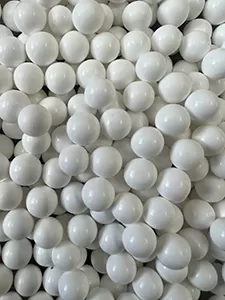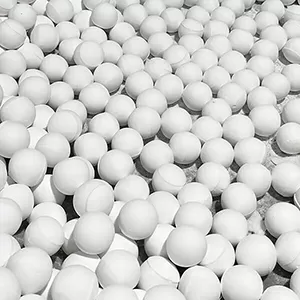Cleaning alumina ceramic balls involves removing contaminants like debris, oil, and grinding residues using methods such as water washing, chemical cleaning, and ultrasonic treatment, with steps tailored to their application and dirt type. Proper cleaning ensures maintained performance, whether they are used as grinding media, packing, or in precision equipment, preventing contamination of processed materials and extending service life.

Water washing is the first step for removing loose debris and surface dust. Alumina ceramic balls are rinsed with warm or cold water, often using a sieve or mesh container to prevent loss. For stubborn particulate matter, gentle scrubbing with a soft - bristle brush helps dislodge particles without scratching the surface. This method is effective for balls used in dry grinding processes, where dust accumulation is the primary issue, and is ideal for preliminary cleaning before more intensive treatments.
Chemical cleaning targets oil, grease, or organic residues, common in applications involving lubricants or organic materials. Mild detergents or alkaline solutions (such as diluted sodium hydroxide) are used, as alumina is resistant to most mild chemicals. The balls are soaked in the solution for 30 minutes to 2 hours, depending on contamination severity, then rinsed thoroughly with water to remove chemical residues. For acidic contaminants, a dilute acid solution (like nitric acid) may be used, but contact time is minimized to avoid damaging the alumina surface, especially for low - purity grades.

Ultrasonic cleaning is highly effective for deep cleaning and removing microscopic contaminants. Alumina ceramic balls are submerged in a cleaning solution (water or mild detergent) in an ultrasonic bath, where high - frequency sound waves create tiny bubbles that implode, generating pressure to dislodge embedded dirt. This method is particularly useful for balls with intricate surface textures or those used in precision applications like bearings, where even small residues can affect performance. Cleaning times range from 10 to 30 minutes, with longer durations for heavily contaminated balls.
High - temperature cleaning is suitable for removing organic residues that resist chemical treatments. Alumina ceramic balls are heated in a furnace at 400–600°C, a temperature range that burns off organic materials without damaging the ceramic structure. This method is often used for balls from industrial grinding processes involving polymers or oils, ensuring complete removal of carbonized residues. After heating, the balls are allowed to cool naturally and are brushed to remove ash before reuse.
Drying is a critical post - cleaning step to prevent moisture - related issues. Balls can be air - dried at room temperature, though this may take several hours. For faster drying, they are placed in an oven at 80–120°C for 1–2 hours, ensuring all moisture is removed. Proper drying prevents mold growth or water spots, which could contaminate materials in subsequent use, especially in food or pharmaceutical applications.
Special considerations apply to alumina ceramic balls used as packing in chemical columns. They must be cleaned with solutions compatible with previous process fluids to avoid chemical reactions. For example, if the packing was in contact with acidic materials, alkaline cleaners are avoided to prevent neutralization residues. Additionally, after cleaning, packing balls are inspected for cracks or wear, as damaged balls may compromise column efficiency.
In summary, cleaning alumina ceramic balls requires selecting methods based on contamination type: water washing for dust, chemicals for oils, ultrasonic treatment for precision cleaning, and high - temperature processing for organic residues. Proper drying and material - compatible cleaning agents ensure the balls retain their properties, maintaining performance across industrial applications.



